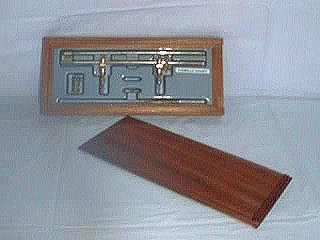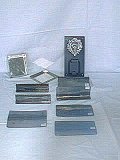








 |
Contact Us | Location | About Us | Pricing | T's & C's | ||||||||
 |
 |
 |
 |
 |
 |
 |
 |
||

Details of the content of the courses that delegates study for their safety certification are shown below.
 |
| Typical examples of a delegate's outcome from this module. |
This course of study is recognised by DATA, the HSE (Health and Safety Executive) and the NAAIDT (Natonal Association of Advisors and Inspectors in Design and Technology).
Delegates may choose to study all modules from the scheme as either short courses or extension modules. These may take place either be during their Initial Teacher Training or as part of their continuing professional development (CPD). Those on an Initial Teacher Training course have an entitlement to Core Level Courses and for secondary teachers modules S1HS and S2HS.
The descriptions below cover modules leading to certification at extension level.
Foreword
The courses to which this certificate refers are taught and examined in accordance with the syllabus negotiated by DATA in association with The National Association of Advisers and Inspectors in Design and Technology (NAAIDT) and the Health and Safety Executive (HSE).
They are approved for use by workshop teachers and technicians in school workshops.
Wood Sawing Machines (S1HS)
Planer/Thicknesser Machines (S8HS)
Environmental aspects including working areas, risk assessments, access, personal protection and management of participants and non-participants in the room. Display of statutory and other notices and instructions, and the Health and Safety in the Workplace regulations (1974).
Principles, equipment and practices of dust particles and chip collection or extraction. Explosive hazards in airborne dust. Fire hazards of un-cleared chipings and shavings.
 |
 |
| Example of a delegate's outcome from this module. | |
Handtools:
Care and maintenance of edge tools and saws.
Secure work holding and control of tools for planing, paring and mortising.
Selection and safe use of boring tools in a pillar drill machine.
Narrow Bandsaw
Electrical controls.
Blade selection, mounting, tracking, guides, tension, and speed setting.
Use of table and fence and fixtures.
Routine maintenance.
Regulations.
Circular Rip Saw
Electrical controls.
Blade design, size and mounting.
Setting of riving knife and guards.
Use of fence.
Feed-rate and use of push stick and spike.
Recognition and correction of faults in cutting.
Position, size and use of take-off table.
Routine maintenance.
Surface Planer/Thicknesser.
Electrical controls.
Positioning and use of infeed and outfeed tables and their relationship with the cutter block.
Use of guards and fences.
Considerations of feed-rate.
Minimum length of work and anti-kickback devices used when thicknessing.
Bandfacer and Disc Sanding Machine.
Electrical controls.
Selection and use of discs and belts,
mounting and tracking of belts.
Speeds and feedrates.
Table adjustment and fences,
Use of jigs and fixtures.
Dust extraction and hazards of mixed dusts from timbers and plastics etc.
Maintenance.
Centre Lathe for Metal Cutting (S2HS)
Milling Machine and Machine Centre (S6HS)
 |
| Example of a delegate's outcome from this module. |
Content of the module include:
Principles of single point cutting, clearance angles, cutting angles, cutting speed, feedrate as factors in efficient material removal and surface finish.
Principles of multi-edged cutters - twist drills, taps, dies, horizontal and vertical milling machine cutters.
The principles and practice of work-holding, with specific practical reference to degrees of freedom and restraint permitted by vices, angle plates, vee blocks and jigs.
Drilling:
Controls and safe usage of pillar and column drilling machines. Speed selection. Fitting arbors to the quill. Fitting drills to the chuck, or directly to the quill. Use of machine and hand vice. Setting work under the drill. Use of depth stop. Use of pilot holes, thin material, ductile material. Disposal of swarf. Deburring.
Health and Safety Aspects:
Introduction to the Health and Safety at Work Act. Risk Assessment and CLEAPSS material. Positioning of machines. Control of work, use of coolants and disposal of swarf.
Turning:
Construction and use of a centre lathe. Holding work in a 3-jaw and 4-jaw chuck. Use of a gearbox for feed changing. Saddle and apron controls. Types of toolposts and tool holders, drilling, plain turning, boring and knurling. Use of tailstock and accessories.
Horizontal Milling:
Construction, features, controls and safe usage of plain milling machines. Cutter types and mounting. Arbor support. Cutter guards.
Upcut and downcut milling including the advantages and disadvantages of each. Design and types of cutter including side and face and staggered tooth. Cutter speeds and feedrates. Manual and automatic feeds. Cutter guards and their setting.
Methods of workholding relative to processes and cutter forces.
Hazards in handling and disposal of swarf. Hazards from burrs produced by the cutting action.
Vertical Milling:
Construction, features and controls including the safe usage of the vertical milling machine.Types and uses of cutters, end mills and slot drills. Types of collets and chucks.
Effects of tool direction and approach of feed.
Manual and powered feeds to X and Y axes.
Locking systems for unused slides.
Methods of work-holding , vices, step-blocks and clamps. Hazards in handling and disposal of swarf. Hazards from burrs produced by the cutting action. Use and setting of coolant supply.
Use of machine dials in working to incremental dimensions.
Powered metal sawing:
Selection of blade and speeds where appropriate for use on the power hacksaw.
Sand casting Non-Ferrous Metals (S3HS)
Health and Safety:
With particular reference to the recommendations made in BS 4163(2007), section 9.4 with regard to :-
 |
| Example of a student's outcome from this module. |
Equipment:
Moulding equipment, materials and methods. Moisture content and 'bulking' effect of greensand. Dressing of sand for re-use.
Types, selection and reversibility and register of moulding boxes.
Single sided, split patterns and oddside moulding methods. Position of patterns, risers and runners and access gates for pouring. Drying, assembling and handling.
Furnaces and Pouring
Operation, control, and maintenance,.
Lighting up and shutting down procedures.
Use of "gas guard".
Crucible types, safe capacity, storage, soundness and use. Charging and recharging, including drying, and pre-heating of ingots.
Use of refractory wash on crucibles and associated materials.
Use of fluxes, degassers with particular attention associated with the reaction and fumes.
Dross removal and safe disposal.
Types and uses of lifting and pouring equipment.
Dangers regarding excessive temperature in the melt and in the mould.
Pouring, cooling, breaking and fettling:
Organisation of the immediate area, mould, lifting equipment, crucible, people, protective clothing. Awareness of dangers when pouring, - blowback, boiling separation of cope from drag.
Pouring methods.
Cooling time related to material and mass of casting. Indication of solidification.
Dangers of steam and black heat retained in the sand.
Dangers of cuts from flash and sawn edges.
Handling irregular shapes for fettling.
Segregation and reclamation of sand.
Restoring moisture content and manual re-dressing with particular reference to lifting heavy masses on shovels (long levers and bad backs!)
Defects in Castings:
Identification of and possible ways of avoiding the following:-
Forming and Fabricating Plastics
 |
| Example of a delegate's outcome from this module. |
Environmental aspects:-
Including positioning of machines, storage of materials, personal protection; physical, respiratory, optical. Management of participants and non-participants in the immediate area of an activity.
Principles, equipment and practices for extraction of fumes and particles from heating, sawing, polishing, moulding and hotwire cutting of thermo-plastic materials.
Burn and fire hazards and precautions.
Care in storage, mixing and use of solvents, resins and catalysts Dangers inherent in uncleared waste and in suspended particle atmospheres.
Equipment and its safe use, including electrical considerations where relevant. Sawing sheet material by circular saw and band-saw. (These aspects are primarily covered in wood machining, but here deal with specific aspects relating to plastics) - thinness and flexibility in sheets, avoidance of heat generation, electrostatic nature of particles etc.
Machining of plastics by turning, milling, shaping and drilling. (The use of these machines is covered in the metalworking course but particular attention is given here to the tooling requirements with regard to the nature of the range of plastics and their brittle tough swarf).
Heating of thermo-plastics by infra-red and radiant heat strip heaters. Control of temperature, avoiding burning of material when hot and soft.
Heating in fan assisted ovens, setting of temperature and over-ride controls, loading ovens for ease of removal of soft sheets, care in handling and carrying hot sheets, proximity of associated ovens and equipment.
Safe use of rotary, disc and belt sanders (bandfacers ) and polishing spindles. Vacuum forming and blow moulding of thermo-plastics, including hazards associated with the use of air-lines.
Injection Moulding of Thermo-Plastics,
Storage and drying of hygroscopic materials.
Oxy-Acetylene Welding (S5HS)
 |
| Example of a delegate's outcome from this module. |
Environmental aspects including installation, access to plant, storage of compressed and dissolved gases.
Personal protection - physical, respiratory and optical.
Management of non-participants in the area.
Statutory and other notices, symbols and colour codes.
Principles, equipment and practices for fume and dust extraction and infiltration, both local to the process and general in the room.
Toxicity and pungency of fumes from some filler rods and fluxes and from base metals containing lead or zinc as alloying elements of surface coatings.
Circumstances relating to working with closed vessels and with items coated with, or containing flammable or toxic materials.
Dangers from spread of un-ignited gas or vapour.
Fire and Burn prevention and emergency action.
Avoidance of inflammable substances within the welding or cutting area. Emergency action in the event of a process-related fire.
Shutting down in the case of evacuation.
Evacuation procedures.
Immediate action in the case of burns.
Further first-aid procedures.
Equipment for gas welding and cutting.
Identification of cylinders and their content.
Thread convention and identification.
Isolator valves,
assembly of regulators to bottles, and hoses to regulators on bottles or manifold systems.
Assembly of mixer or cutting attachment and nozzles to torches.
Hazards of oil or grease in the presence of oxygen.
Non-return valves and flashback arrestors.
Testing for leaks with "Teepol".
Procedures for commissioning
Taps and regulators.
Opening the bottle valves.
Selecting and setting line-pressures.
Consideration of flow-rate with respect to bottle capacity.
Lighting up,
Flame adjustment for purpose,
extinguishing the flame.
Relighting after inadvertently extinguishing the flame.
Closing down.
Practice
Preparation of butt, fillet, lap and corner joints, including gap setting where appropriate.
Catering for expansion and controlling distortion.
Selecting, setting and control of torch and filler rod for leftward and rightward methods,
Filler rod used flat, horizontally and vertically.
Recognition and remedies of faults in welded joints.
Bronze welding.
Brass welding.
© Amethyst Consultancy. 2004-2020
For all products and systems designed by us on behalf of our clients the company's terms and conditions apply.